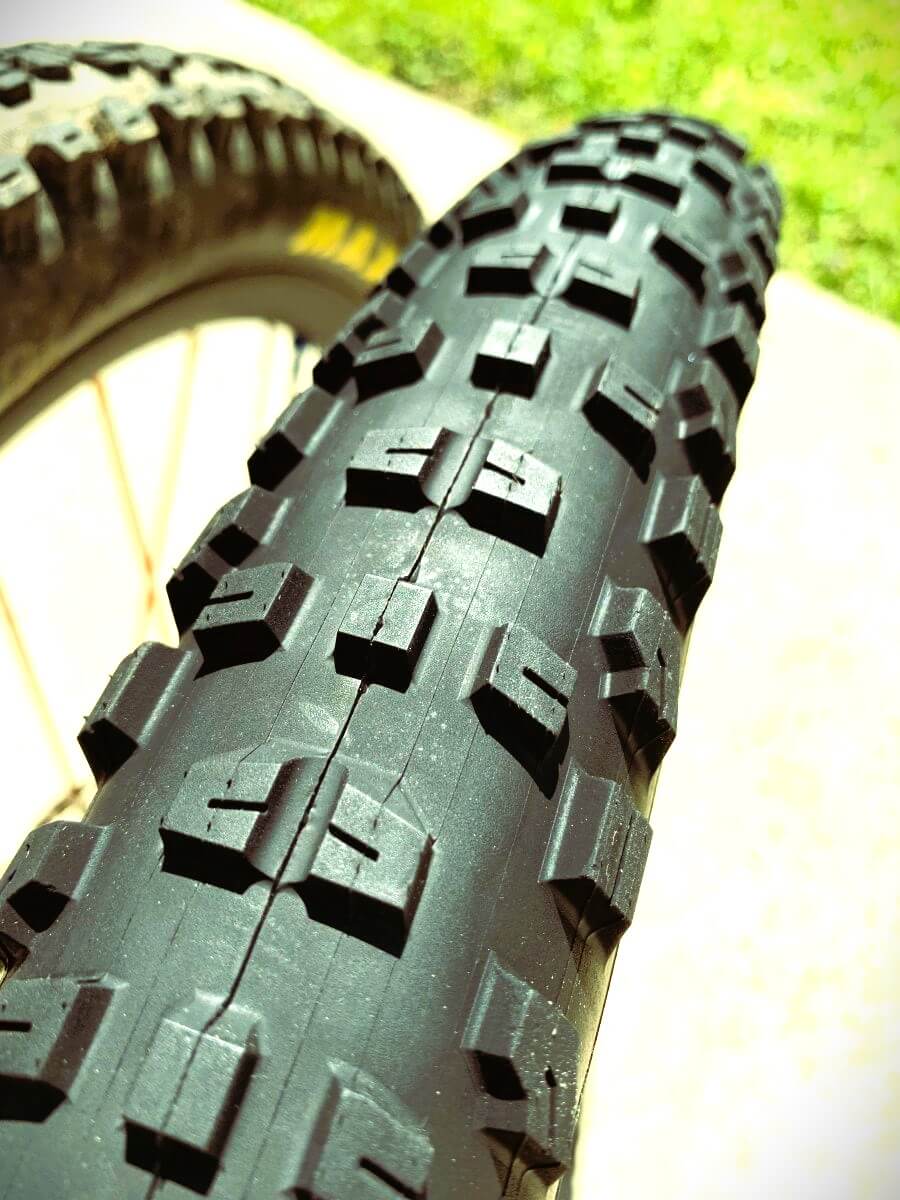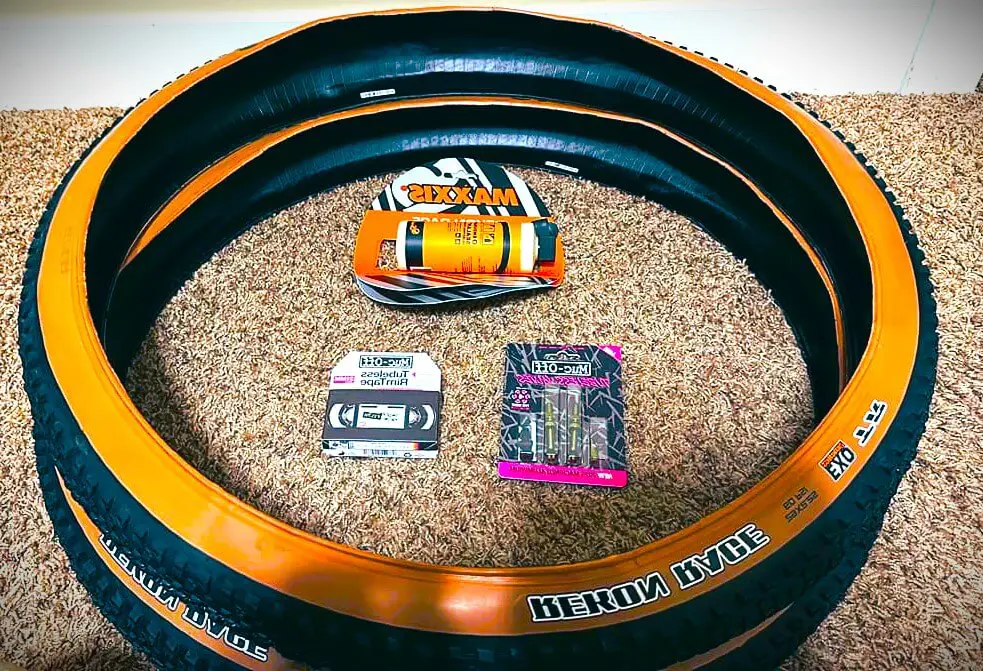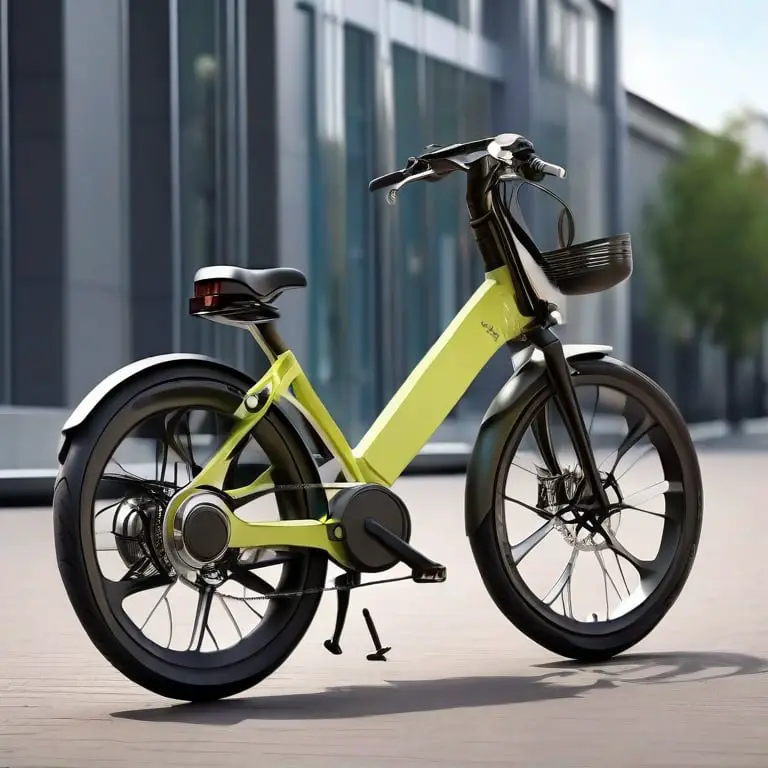25mm Vs 28mm Tires [Finding The Perfect Fit]

As an affiliate, we may earn from qualifying purchases. We get commissions for purchases made through links on this website. You can read more on our Affiliate Disclaimer here.
Are you ready to hit the road with tires that can revolutionize your cycling experience? If so, prepare yourself for a thrilling debate between two contenders: the 25mm vs 28mm tires.
The key difference between 25mm and 28mm tires is their width. 25mm tires are narrower, offering lower rolling resistance and aerodynamic advantages.
Thus, they are suitable for racing on the road. In contrast, 28mm tires provide greater comfort and stability on mixed surfaces and urban commutes. The choice depends on riding preferences and terrain.
We’ll examine the pros and cons of each size, dissecting their performance on various terrains and deciding which size is best.
So, Get ready to ride into the world of tire comparisons like never before!
25mm tires: A Comprehensive Discussion
In recent years, 25 mm tires have become increasingly popular among cyclists due to their versatility. This mid-range tire size offers a balance between speed and comfort.
As a result, it is well-suited to a variety of riding conditions.
With a more comprehensive profile, it provides better traction and stability compared to narrower tires. Its improved rolling resistance is one of its notable advantages.
A larger contact patch reduces friction, allowing speed to be maintained with less effort. Long-distance rides or races benefit greatly from it.
Also, It offers enhanced puncture protection without sacrificing speed. Thanks to its increased air cushioning, it protects the road from glass shards and thorns.
With this added durability, riders can explore different terrains or commute through urban areas.
Advantages of 25mm Tires
- Good aerodynamics.
- Lower rolling resistance.
- Climbing efficiency.
- Puncture resistance.
- Potential weight savings.
- Versatile for various road riding.
- Compatibility with tight clearance frames.
- Adequate cornering performance.
- Efficient acceleration.
Disadvantages of 25mm Tires
- Reduced ride comfort.
- Needs to be fixed in installation.
- Limited off-road capability.
- Less comfort on rough roads.
28mm Tires: A Comprehensive Discussion
Usually, 28mm tires are a versatile choice for cyclists, offering a unique blend of comfort and speed.
This tire is popular for smooth and moderately rough road surfaces, making it an excellent choice. On well-maintained roads, they provide a more comfortable ride.
They perform well in urban commuting, paved city trails, and bumpy asphalt roads. A 28mm tire comes with a lightweight, narrow profile.
It is compatible with most frame sizes and provides easy fender installation.
Although they provide speed and adaptability, their slim design can make them more challenging to change.
They may not absorb shock well, making them less suitable for off-road adventures.
Finally, choosing 28mm tires is based on the rider’s preferences and the specific riding conditions they intend to conquer.
Advantages of 28mm Tires
- Increased comfort and smoother ride due to a larger volume of air in the tire.
- Improved traction and grip on various surfaces.
- Fit various bike frames and allow for easy fender installation.
- Better shock absorption.
- Provide a more stable and controlled ride.
- Lower rolling resistance compared to wider tires.
- Faster speeds on smooth roads.
- Better Puncture Resistance.
- Suitable for both road cycling and light off-road adventures.
Disadvantages of 28mm Tires
- Limited off-road capability.
- A thinner profile can make tire changes more challenging.
- Less compatibility.
- Insufficient shock absorption.
25mm vs 28mm Tires Comparison Table
Here is a comparison table that examines the differences between 25mm and 28mm road bike tires. For a quick overview of the differences, check out the chart below!
| Aspects | 25mm Tires | 28mm Tires |
| Speed | Excellent acceleration and speed on smooth surfaces | Maintains good speed while offering improved comfort |
| Weight | Potentially lighter (depends on the model) | Lightweight and efficient |
| Air Pressure | A thinner profile can make installation more challenging | Lower, more forgiving, provides a smoother ride |
| Compatibility | Compatible with most road bike frames and forks | The thinner profile can make installation more challenging |
| Aerodynamics | Decent aerodynamic performance | Offers a balance between aerodynamics and comfort |
| Shock Absorption | Limited shock absorption on rough roads | Provides better shock absorption on moderately rough roads |
| Acceleration | Quick acceleration due to lower rotational mass | Slightly slower acceleration compared to 25mm tires |
| Terrain Suitability | Best for well-maintained, smooth roads and road racing | Versatile for urban commuting, city trails, and mixed road surfaces |
| Cornering Performance | Adequate for dry road conditions | Good cornering performance for urban riding and mixed surfaces |
| Ride Comfort | Not suitable for off-road or rugged terrain | Limited off-road capability but adaptable to mixed road conditions |
| Rolling Resistance | Typically lower due to narrower profile | Slightly higher rolling resistance compared to 25mm tires on smooth roads |
| Tire Change Difficulty | Easier to install and change | Thinner profile can make installation more challenging |
Difference between 25mm and 28mm Tires
The difference between 25mm vs 28mm tubeless tires may seem minimal, but it can have a significant impact on your cycling experience.
The most obvious distinction is in the width of the tires, with 25mm being narrower than 28mm.
This difference affects several aspects of your ride. Now let’s get into the details!
Speed:
In well-maintained, smooth roads, 25mm tires are notorious for their speed and acceleration. Riders seeking maximum speed, such as those participating in road races or high-speed training rides, prefer 25mm tires.
You can sprint, chase down rivals, or maintain a high speed on flat and smooth surfaces with a 25mm tire.
In contrast, 28mm tires maintain good speed on smooth roads but may achieve a different level of swiftness. However, 28mm tires are not as narrow as 25mm tires.
They still provide a balanced combination of comfort and speed. Even though 28mm tires are not as aerodynamically efficient as 25mm tires on ultra-smooth roads.
They provide shock absorption and stability on less-than-ideal roads.
Weight:
Compared with their more comprehensive counterparts, 25mm tires tend to be lighter in weight. They save weight with a narrower profile and a smaller tire volume.
A narrower tire typically requires less manufacturing material, resulting in a lighter tire. In competitions, cyclists and riders pay close attention to the weight of their components.
The lighter the tires, the better the climbing abilities and acceleration. Even a few grams saved can make a big difference during races.
But 25mm tires, and 28mm tires are slightly heavier because of their increased volume. The wider the tire, the more rubber and material it contains, naturally adding weight.
This extra weight may be noticeable to riders highly attuned to their bikes’ performance characteristics.
Air Pressure:
Typically, 25mm tires require higher air pressure to maintain shape and performance. Due to their narrow profile, these tires require a specific pressure range to minimize pinch flats.
For 25mm tires, pressure adjustments may be more sensitive due to the higher air pressure required. Even minor variations in tire pressure can noticeably impact the ride quality.
Conversely, 28mm tires can run at lower air pressure while providing proper support for the rider. When the air pressure is reduced, the broader and deeper tire provides more forgiving handling.
With lower air pressure and better shock absorption, 28mm tires perform well on moderately rough roads.
Compatibility:
In general, 25mm tires fit most road bike frames and forks. They have a narrower profile and are compatible with most road bikes.
It is beneficial for riders with traditional road bikes equipped with narrower tires. A few modern road bikes have limited tire clearance to improve aerodynamics.
It might be possible to fit 25mm tires, but there might be little room for error.
On the other hand, 28mm tires offer improved compatibility with a broader range of bike frames and forks.
They can comfortably fit many road bike setups due to their increased width and volume. Riders who value versatility and want to use wider tires will appreciate this extra room.
Aerodynamics:
For riders focused on maintaining high speeds during road races, 25mm tires offer decent aerodynamic performance.
Due to their thinner profile, these tires have a lower frontal area, which reduces aerodynamic drag. As a result, riders can reach and sustain higher speeds because of reduced drag.
Despite their aerodynamics, 28mm tires are comfortable, making them suitable for various road situations.
These tires may be less aerodynamically efficient than 25mm on perfectly smooth roads, but they offer a compromise many riders prefer.
These tires are ideal for riders prioritizing comfort and enjoyment over aerodynamic efficiency.
Shock Absorption:
25mm tires provide limited shock absorption, especially on rough roads. With 25mm tires, the tire has less air due to its narrower width.
This limited air volume has less capacity to absorb and dampen road vibrations and impacts.
Due to this, riders with 25mm tires may have a harsher and less comfortable ride on rough roads.
In contrast, 28mm tires offer better comfort and shock absorption on moderately rough roads. As a result of the increased tire size and width, there is more air within the tire, which helps dampen road vibrations.
With 28mm tires, you get a smoother, more forgiving ride because they run at lower air pressure.
Acceleration:
A 25mm tire’s lower rotational mass is primarily responsible for its quick acceleration. In cycling, rotational mass refers to the weight of the tire and wheel.
With less mass located farther from the center of the wheel (the hub), the rotational inertia is reduced. As a result, the tire and wheel combination spins faster and consumes less energy.
Conversely, 28mm tires, while still offering respectable acceleration, may exhibit slightly slower acceleration compared to 25mm tires.
This is due to the increased tire volume and slightly higher rotational mass. Compared to 25mm tires, 28mm tires use slightly more rubber and material in their construction.
When compared to 25mm tires, this added weight can significantly affect acceleration.
Terrain Suitability:
25mm tires offer excellent speed and efficiency on perfectly smooth road surfaces. They are the preferred choice for road racing, where speed and aerodynamics are paramount.
They allow cyclists to achieve and sustain high speeds during races and training rides. 25mm tires may be less comfortable or forgiving on rough or uneven roads.
In contrast, 28mm tires offer versatility and are well-suited for a broader range of terrain conditions.
They are lovely to riders seeking a more comfortable and enjoyable ride. If you commute in an urban area where road conditions vary, 28mm tires are an excellent choice.
Rolling Resistance:
Rolling resistance is the force that opposes the forward motion of a tire as it rolls along the road surface. With 25mm tires, the road has less friction, so forward motion is more efficient.
Because of their lower rolling resistance, these tires improve efficiency and speed on smooth, well-maintained roads.
On perfectly smooth surfaces, 28mm tires offer excellent ride comfort and versatility but experience slightly higher rolling resistance.
Most cyclists won’t notice a significant difference in rolling resistance between 28mm and 25mm tires.
Change tires:
25mm tires are generally easier to install. The key factors influencing their ease of installation include.
As 25mm tires have less material, they are lighter and more flexible, making mounting and dismounting easier.
When cycling, 25mm tires provide an efficient and hassle-free tire-changing experience.
In contrast, 28mm tires, with their slightly more comprehensive profile, can be more challenging to insert into or remove from rims.
The broader width of 28mm tires means there is more material and rubber to stretch over the rim. This additional material can make the tire less pliable, requiring more effort during installation.
Which Tire Size Is Best For Cycle?
The best tire size for a bicycle depends on the rider’s specific needs and the riding they intend to do. With its excellent speed, comfort, and stability balance, 28mm tires are versatile and comfortable.
Usually, when choosing the right tire size for your cycle, there’s no one-size-fits-all answer. It largely depends on what type of riding you’ll be doing and the specific conditions of your ride.
A thinner tire size would be ideal for those looking for speed and efficiency on smooth roads. Thinner tires create less rolling resistance and allow you to glide effortlessly. It gives you increased speed.
On the other hand, if you’re an adventurer who enjoys off-road trails or tackling rugged terrain, opting for wider tires is a better choice.
Having wider tires gives you better traction and stability. Also, It allows you to drive on uneven surfaces confidently. They absorb more shock from bumps and improve overall comfort during long rides.
So, It’s ultimately about matching your riding style with the terrain you encounter.
Most often when choosing the correct tire size, Consider speed, efficiency, grip, comfort, and durability when choosing a tire size that suits your needs.
Remember that experimenting with different sizes can help fine-tune your cycling experience. It’ll enhance your enjoyment on the road or trail, too.
Are 28mm Tires Faster Than 25?
Typically, 25mm tires offer a slight speed advantage over 28mm tires. Because They have a narrower profile, which decreases rolling resistance, this can make a difference in road racing and situations where every fraction of a second counts.
There is generally no significant difference in speed between 25mm and 28mm tires for recreational cyclists.
Moreover, factors such as tire quality, tire pressure, road surface, and rider fitness play significant roles in determining overall speed.
While 25mm tires might be marginally faster on perfectly smooth roads, 28mm tires offer advantages in comfort, stability, and versatility.
On less-than-ideal surfaces, they provide a smoother, more forgiving ride.
In many riding scenarios, including urban commuting and mixed surfaces, 28mm tires are worth the trade-off in speed for improved comfort and adaptability.
It comes down to personal preference when choosing 25mm or 28mm tires.
Do Pro Cyclists Use 28mm Tires?
Pro cyclists typically use narrower tires, often in the range of 22mm to 25mm, for road racing. These narrower tires are favored for their lower rolling resistance and aerodynamic advantages. During competitive racing, this can make a significant difference.
The race course and conditions primarily determine the choice of tire width. It provides better traction and comfort on cobbled sections like Paris-Roubaix.
Some pro cyclists choose wider tires for their training bikes for everyday training and non-competitive riding.
As a result, these tires provide improved comfort and versatility in various road conditions.
However, pro cyclists use narrow tires for road racing but wider tires on their training bikes for enhanced comfort and versatility. The choice of tire width depends on the specific race and training objectives.
Do Bigger Tires Give You More Speed?
Not exactly! On smooth roads, bigger tires are sometimes slower. Generally, narrower tires offer better aerodynamics and lower rolling resistance, allowing for higher speeds.
Usually, the relationship between tire size and speed is complex. Narrower tires can result in higher speeds on smooth roads due to their lower rolling resistance and better aerodynamics.
However, wider tires provide stability and comfort on rough terrain, potentially improving speed over challenging surfaces.
The choice should consider terrain, rider comfort, and personal preferences.
Ultimately, the impact of tire size on speed is influenced by various variables, and no definite answer applies.
25mm front 28mm rear
Your statement “25mm front 28mm rear” seems to refer to measurements that could apply to a variety of contexts, such as tire widths for bicycles, motorcycles, cars, or possibly the specification of parts in machinery or electronics.
To provide a meaningful response or assistance, I need a bit more context. Could you clarify what you’re referring to with these measurements?
Final Verdicts
The choice between 25mm vs 28mm tires ultimately depends on your needs and preferences as a cyclist.
If you prioritize speed and aerodynamics, the narrower 25mm tires may suit you better.
Alternatively, the wider 28mm tires may be better if comfort and stability are your primary concerns.
When making this decision, it is essential to consider factors such as road conditions and personal riding style.
In the end, test riding both sizes and consulting experienced cyclists will help you determine your needs. Be sure to examine your needs before buying a tire so you can make an informed choice.

Steven is a professional cyclist and his passion is cycling. He has been cycling for the last 6 years and he loves using bikes while outing as well. Based on his experiences with the different types of bikes; he is sharing his opinions about various bikes so that a beginner can start right away. Find him on Twitter @thecyclistguy Happy Biking.




